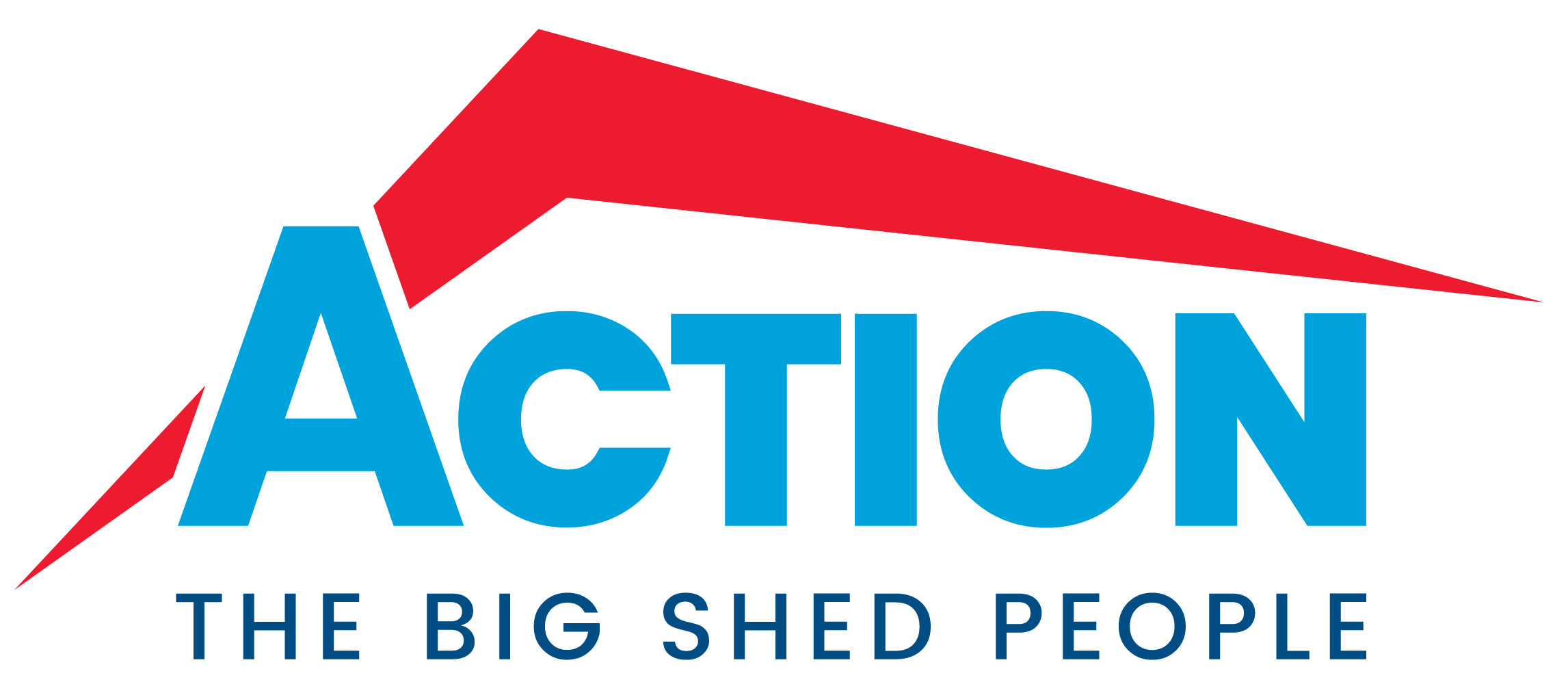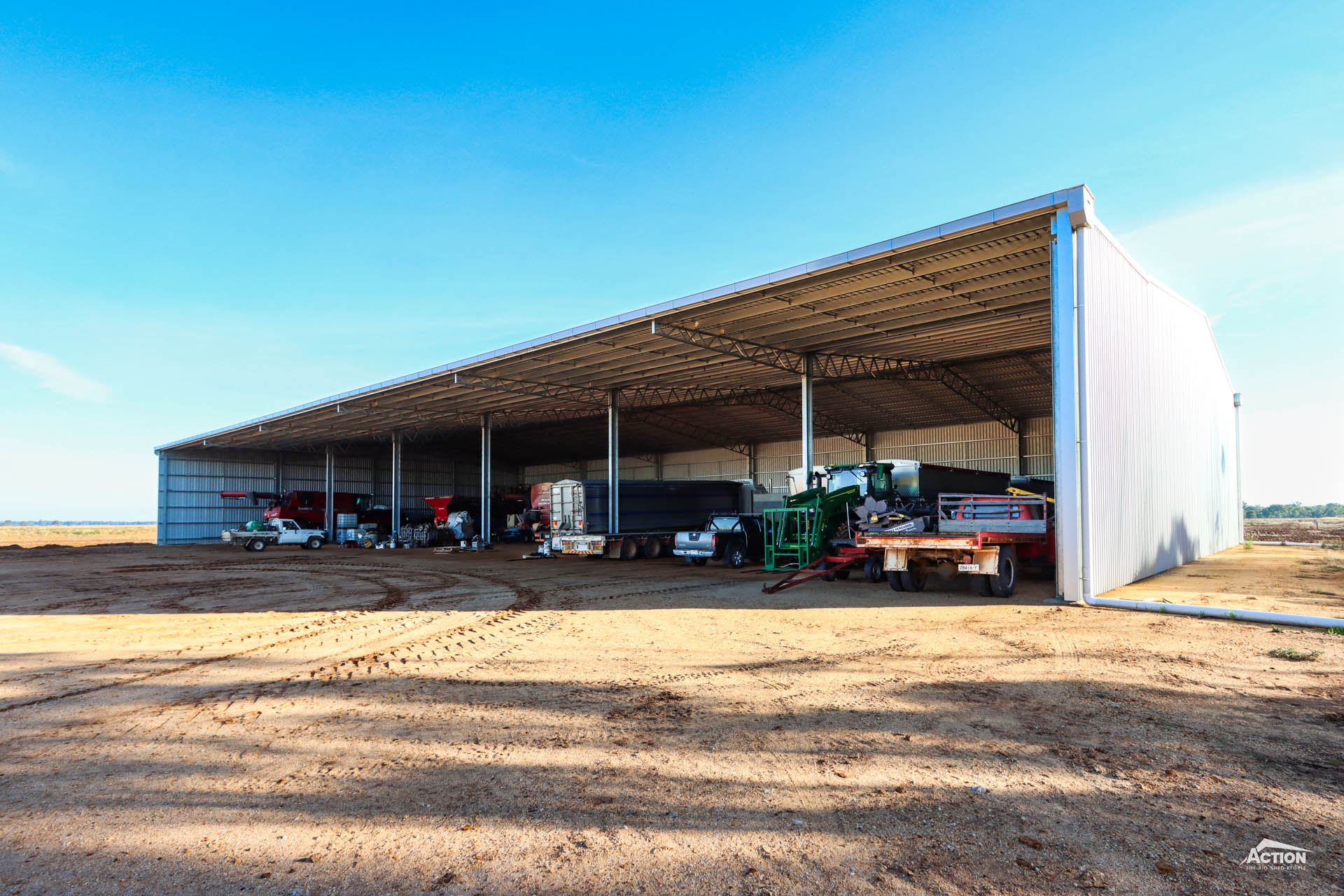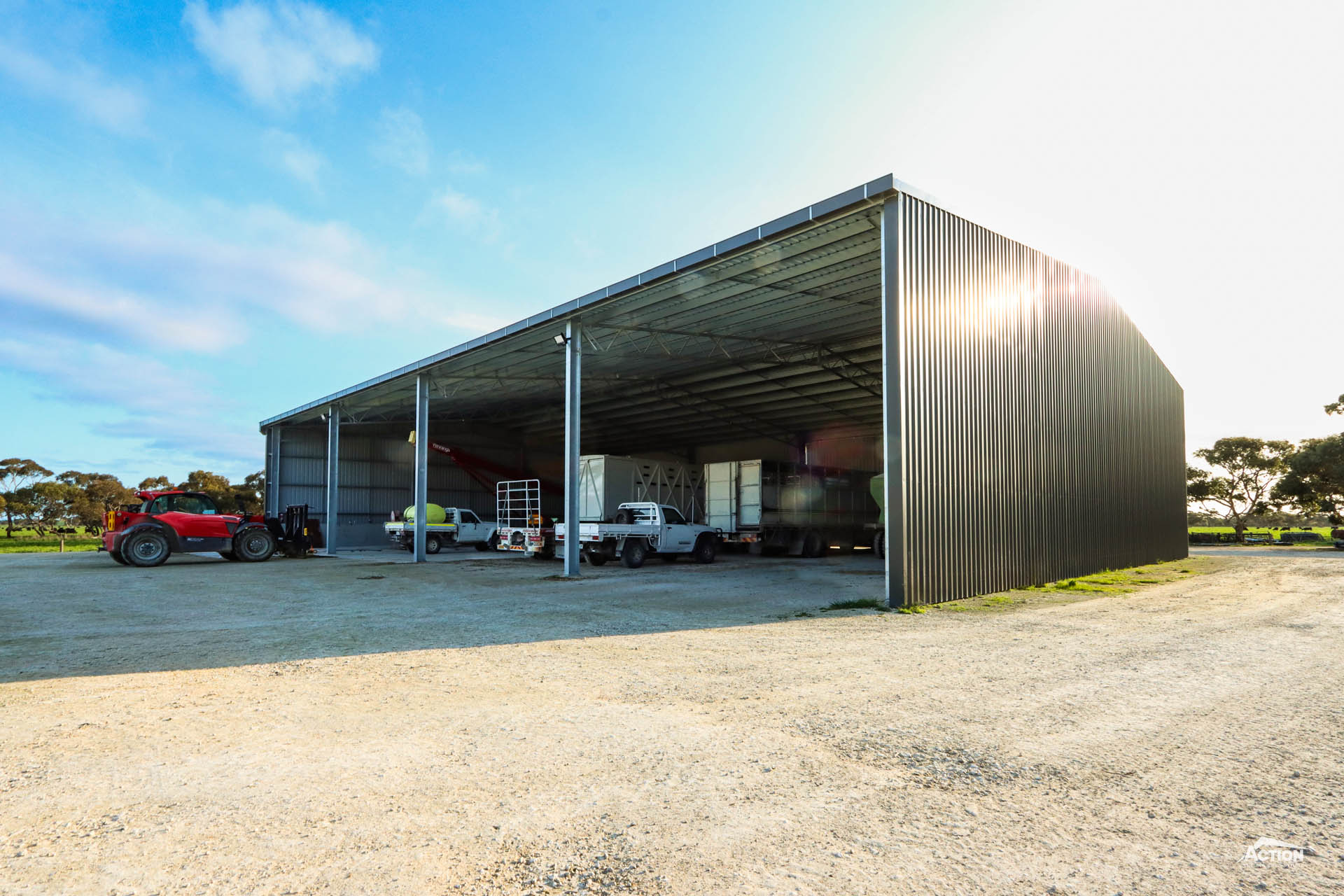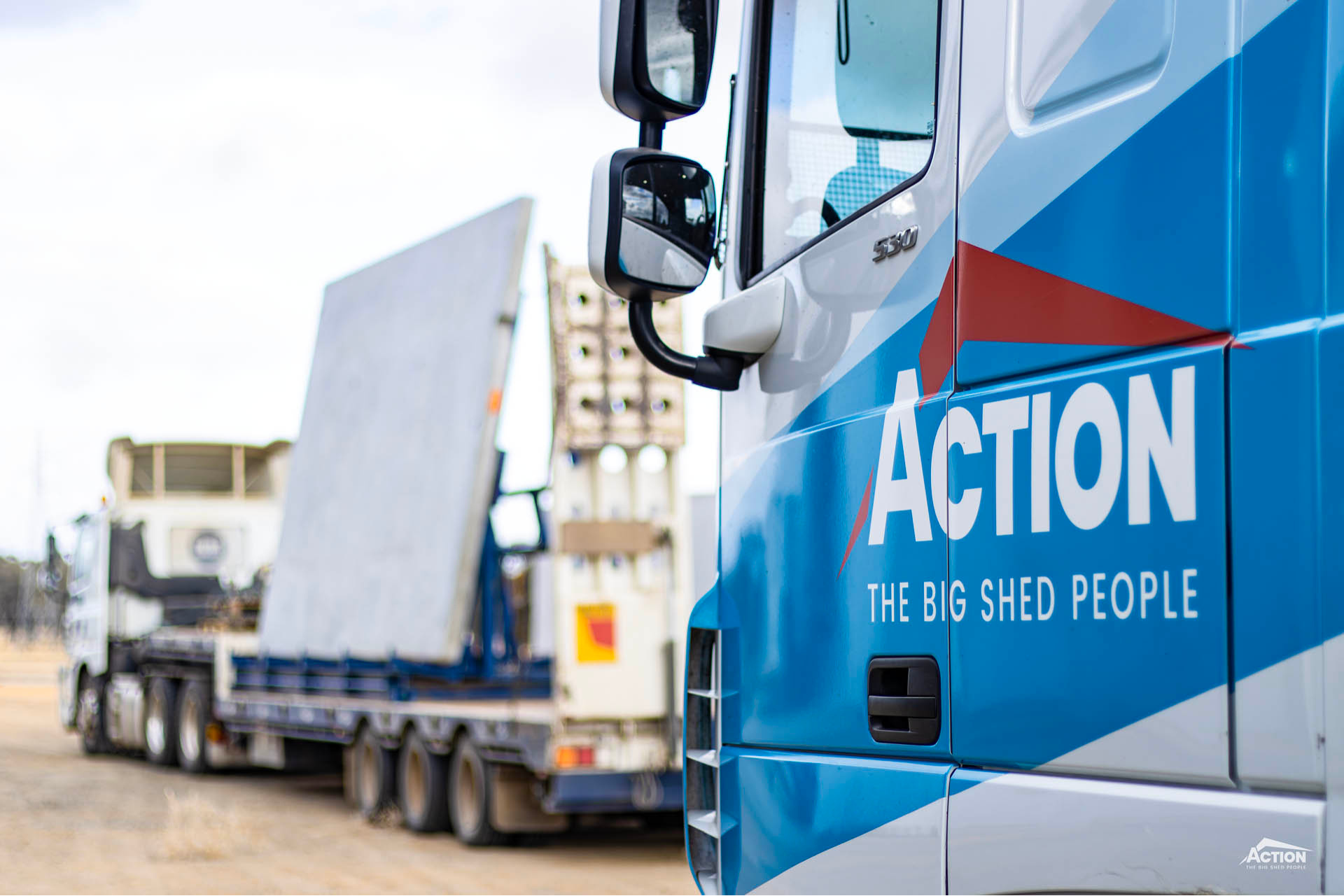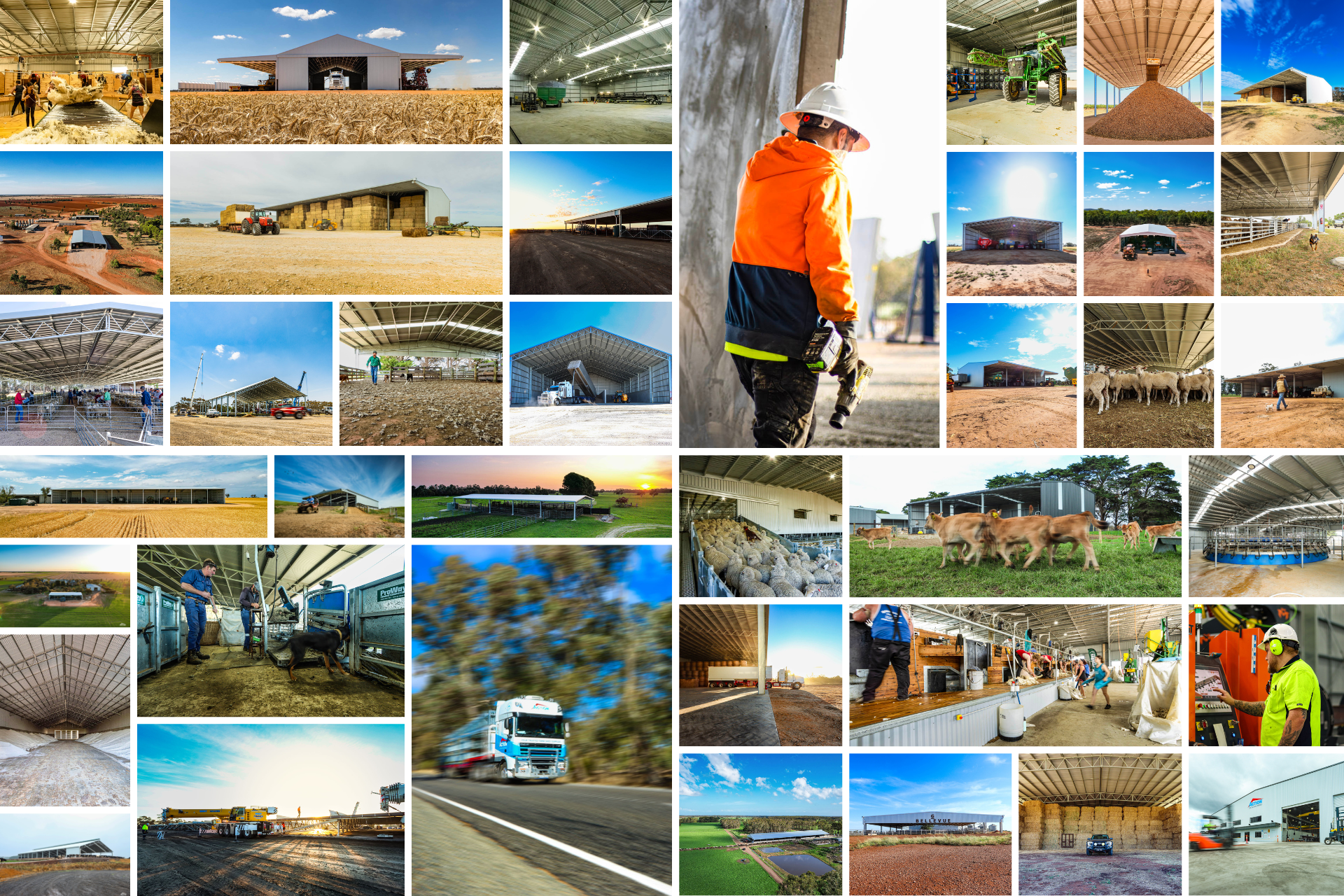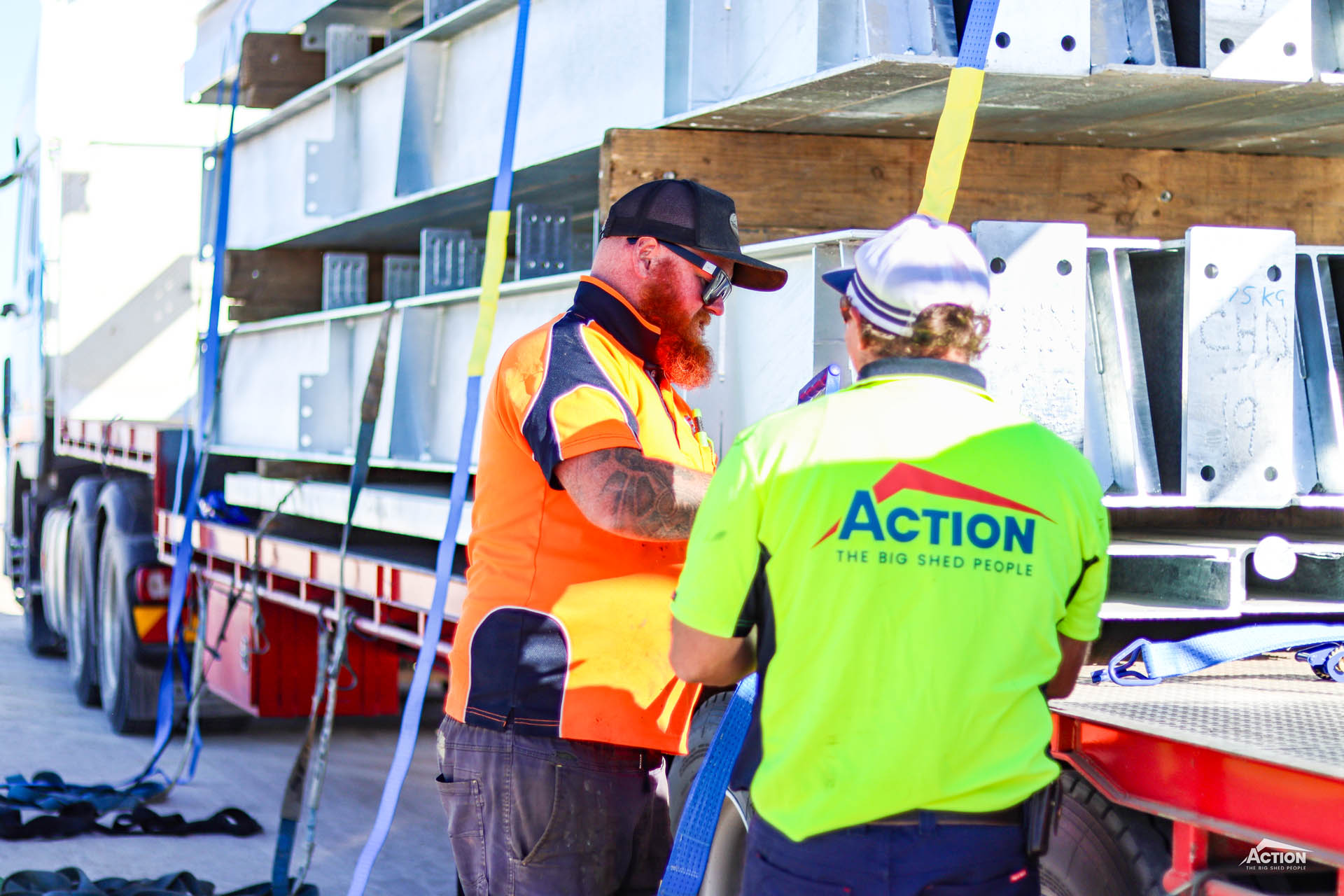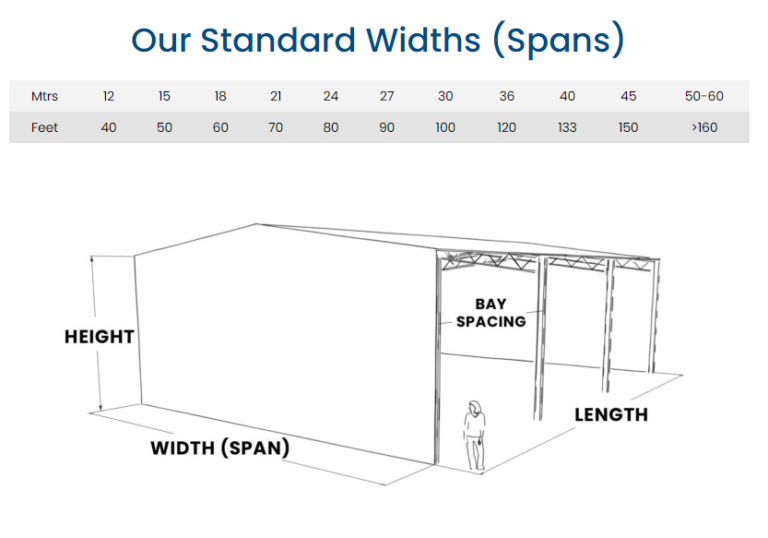Got farm shed questions? We’ve got answers!
Our building consultants speak with thousands of farmers every year about their shed projects –which means they are the perfect choice to answer the top five questions about farm sheds.
In this video, Jason and Lennie answer:
- What is the best bay spacing?
- What direction should I face my shed?
- Can I build a shed near a property boundary?
- Can I build a shed near a powerline?
- Should I choose Trimclad or corrugated iron?
Watch and learn below, or if you would prefer to read about it in detail, scroll on for more information on each topic.
Top 5 Farm Shed Questions, Answered
1
What Is The Best Bay Spacing?
Generally, the standard-size farm shed bay spacing is 8 metres wide. This works well for the majority of farm shed builds.
However, the best bay spacing for your farm shed project will depend on the use of the shed.
Hay Shed Bay Spacings
The best-practice bay spacings for hay sheds have evolved over the last ten years – ten years ago the go-to bay spacings for hay sheds were 6 metres or 7.5 metres.
Since then, hay shed bay widths have increased to 8 metres, 8.5 metres, 9 metres and even 10 metres.
While eight-metre bay spacings are still a practical and cost-effective option, 8.5-metre bay spacings can provide some additional benefits.
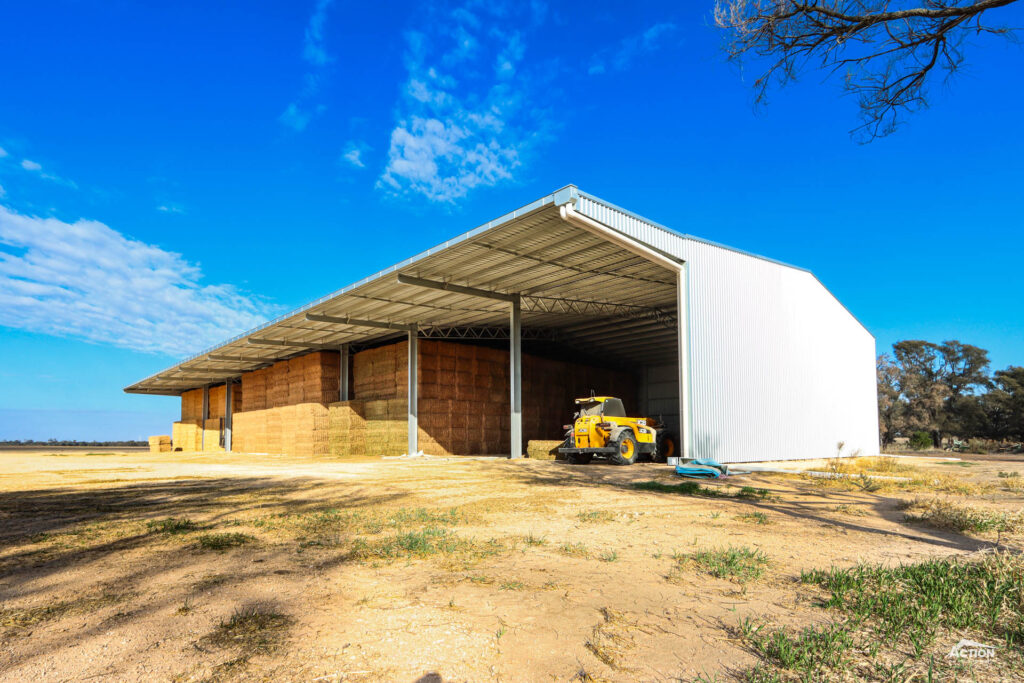
You can learn about these benefits in our article – 7 Best-Practice Hay Shed Design Ideas.
It is also a good idea to consider your future requirements.
For example, if you have large machinery that will be accessing the shed or will be stored in the shed, choose a bay spacing to suit. This is a great way to future-proof your shed. Farm machinery isn’t getting any smaller!
The increasing size of farm machinery is also why some cropping operators are choosing 9-metre or 10-metre bays. Export hay facilities also typically use 9-metre or 10-metre bay spacings.
Machinery Shed Bay Spacings
When it comes to machinery sheds, we generally recommend bay spacings of 8 – 9 metres.
However, bigger bay widths such as 10 metres wide, are becoming more popular to ensure there is ample room when moving large farm machinery.
Another option to consider for machinery sheds is a double bay opening. This is usually created with a girder truss spanning the width of two bays. For example, two 8 metre bays with a girder truss will create a 16 metre wide opening.
While this can work well for wide machinery storage, it usually isn’t the most cost-effective option.
If you require a wide access opening to your machinery shed, consider choosing an open gable end or drive-through configuration. This also works well for long machinery storage. Win-win!
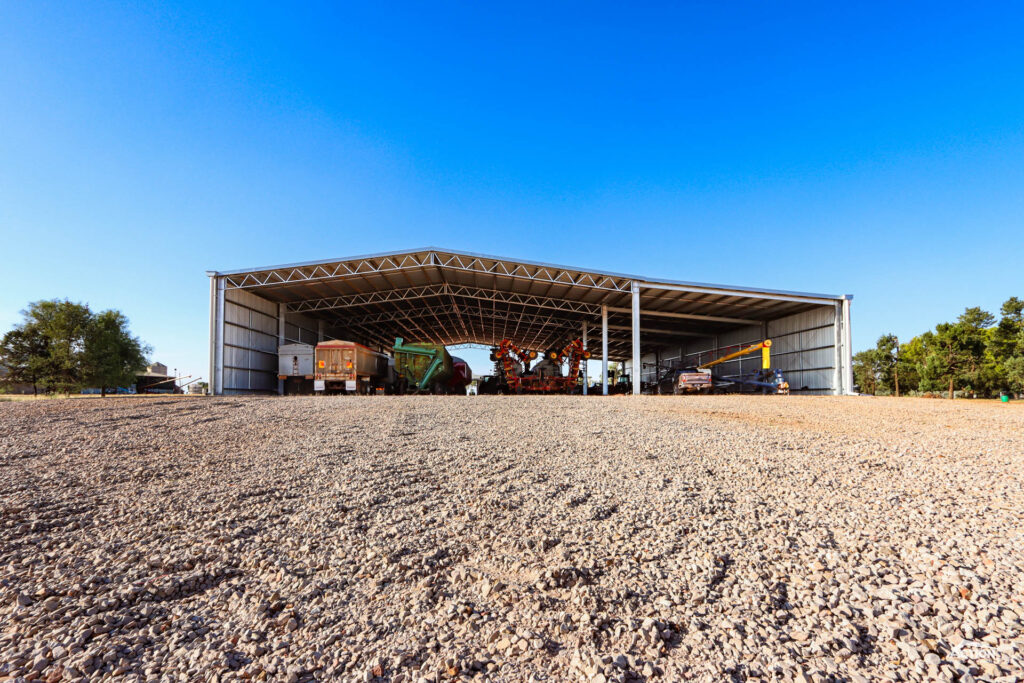
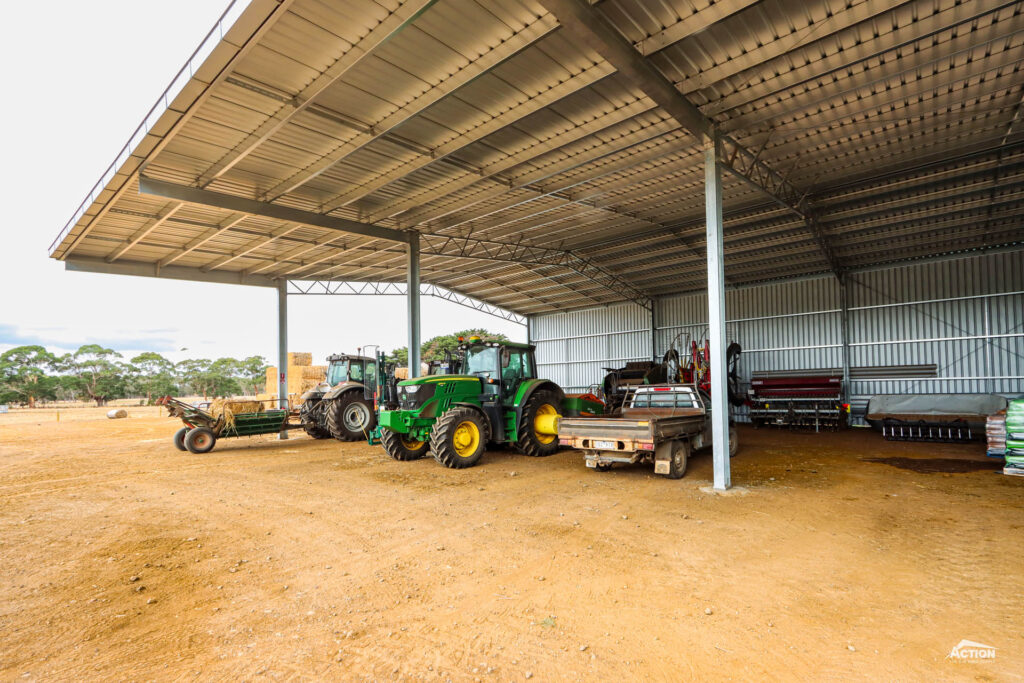
Yard Cover Bay Spacings
To avoid the column placement interfering with gateways, handlers or crushes we vary the widths of the bays throughout the cover to accommodate the yard design and layout.
We work with closely with yard suppliers such as ProWay Livestock Equipment and Te Pari, sharing plans and designs. We also visit site to take measurements and assess the site. This all helps to ensure a neat and seamless fit.
So, that’s an overview of bay spacings!
Next up in our discussion on farm shed questions, is farm shed orientation.
2
What Direction Should I Face My Shed?
Farm shed orientation is a popular topic – which is why it is one of the most common farm shed questions – and an important one too.
Firstly, your farm shed orientation will determine how well the contents of your shed are protected.
Secondly, it will also influence the airflow through the shed. This is a very important consideration for contained housing systems for dairies and feedlots.
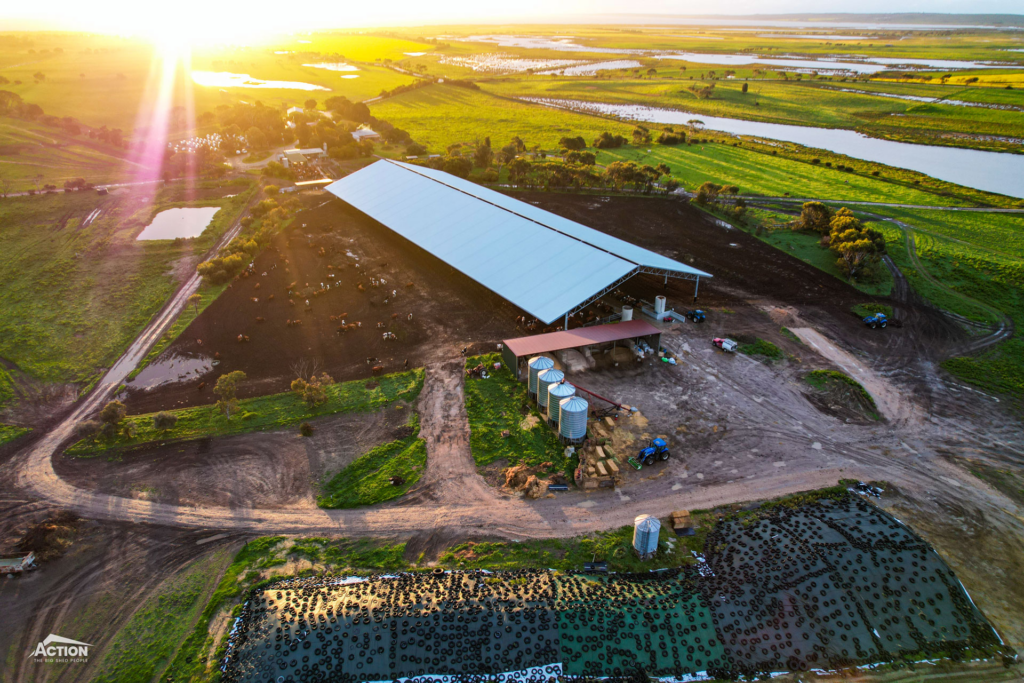
(If you are building a dairy barn, you might find this article helpful – What Is The Best Loafing Barn Orientation?)
Not sure which direction to face your farm shed? Below we provide an overview of the advantages and disadvantages of each orientation option.
Remember, the best orientation for your farm shed can also depend on the local climate and site conditions such as exposure to the prevailing weather or existing infrastructure.
First up – facing your shed north.
North Facing Shed Orientation
Pros:
- Positioning your shed so that the opening is facing north will mean that the pad at the front of the shed will remain the driest. This is due to the way in which the sun moves across the sky – the front of a north-facing shed will always have direct sunlight.
- The inside of your shed will remain well-lit due to the amount of sunlight coming in from the northern opening.
Cons:
- Often stormy weather blows down from the north, meaning that strong winds and rain may blow into the open side of your shed
- Sunlight can shine a long way into your shed, this may mean that machinery components are at risk of being impacted.
South Facing Shed Orientation
Pros:
- Having a shed open to the south will mean that you will get very little sunlight into your shed – this ensures the best protection from sunlight for goods stored within the shed
Cons:
- The pad at the front of the shed can tend to remain boggy during wet months, due to the fact that the southern side will always be shaded
- Wind tends to often come from the south, meaning the interior of your shed may be more difficult to keep clean
West Facing Shed Orientation
Pros:
- Nil
Cons:
- As a general rule, all-weather comes across from the west. Having a shed open to the west offers the least protection for goods stored within the shed. It normally also means that the engineers will have to increase material size, and the cost of the shed will increase.
East Facing Shed Orientation
Pros:
- Opening a shed to the east is by far the most common choice.
- As a general rule, very little weather comes in from the east. This will mean that goods stored within your east-facing shed will be very well protected from the elements
- With an east-facing shed you will get some morning sun on the front of the shed, meaning that the pad will keep relatively dry, but for the remainder of the day your goods will be protected from direct sunlight.
Cons:
- Nil
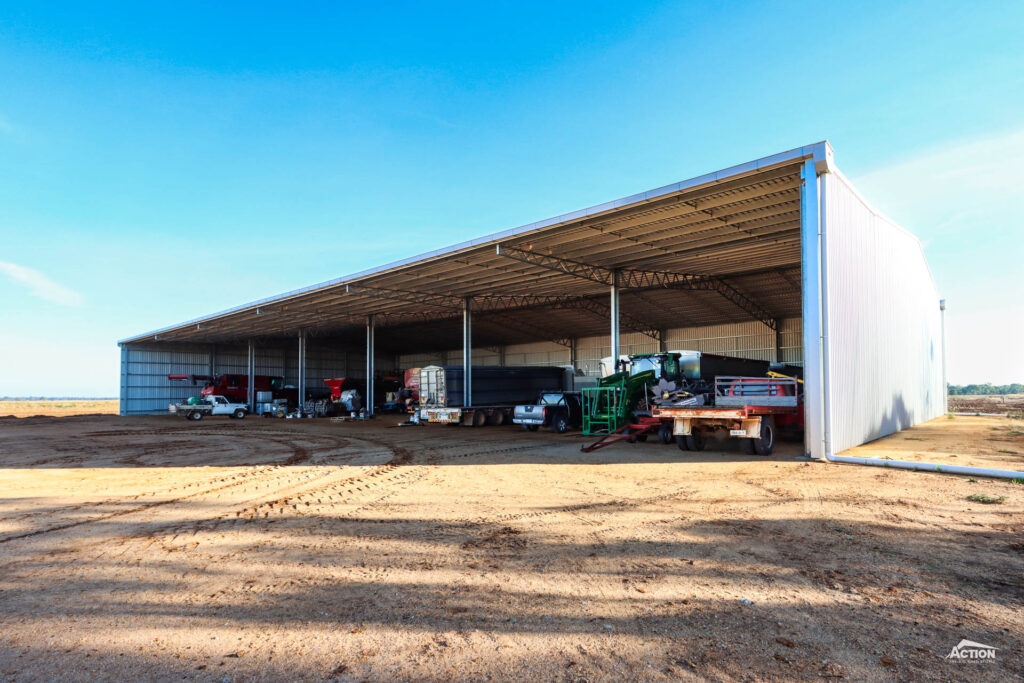
That’s a wrap on farm shed orientation.
Next in our list of farm shed questions is, – Can I Build A Shed near A Boundary?
This question is a common one for those who are building closer to town or near a neighbouring property.
3
Can I Build A Shed Near A Boundary?
The short answer to this is – yes!
However, there are a few requirements that need to be addressed. For example, in Victoria, the location of a farm shed needs to comply with several required setbacks.
Read on to learn about an overview of some of the main setbacks, potential outcomes and workarounds.
Setbacks
- 20m off a local council road
- 100m off a main road (Highway)
- 5m off a property boundary
- 100m away from a dwelling in a different ownership
- 100m away from a waterway
If you are unable to satisfy these requirements, your farm shed project will need a planning permit to progress any further.

Planning Permits
While planning permits are an additional cost, sometimes they are unavoidable. They can also be time-consuming, however, we look after the application process for you.
You can learn more about planning permits, here – What Is The Difference Between A Building Permit And A Planning Permit?
Changing the location of your shed (where practical) may help you avoid having to get a planning permit (provided that there are no overlays on your property). This could save you time and money.
Now on to farm shed question number four – Can I Build A Shed Near A Powerline?
4
Can I Build A Shed Near A Powerline?
If you are looking to build a shed near a powerline – or under a powerline – it is a good idea to do your research.
This is because there are several restrictions and requirements that you need to be aware of. These may affect how your shed is built or increase project costs.
First and foremost, whether you are allowed to build near or even under the powerline usually depends on two things:
1. The type of powerline
2. Your powerline provider.
For example, the restrictions for a distribution overhead powerline will be different to the restrictions for a transmission overhead powerline.
This is why we recommend you contact your local provider. They will be able to confirm the exact measurements and any requirements that need to be met. This includes calculating the potential ‘sag and sway’ over the powerlines such as the potential movement of the wire on a hot, windy day.
No Go Zones When Building Near A Powerline
How close can a powerline be to my shed? What is a no go zone?
Generally speaking, the closest a powerline can be to a shed is within three metres. Any closer than this is regarded as a ‘No Go Zone’
This graphic is a good visual explainer of No Go Zones. You can also learn more about these, here.
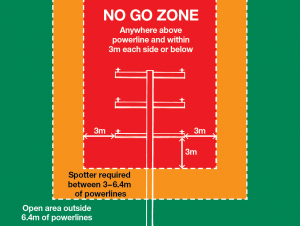
Building Near A Powerline?
There are several points to be aware of, including these three:
- If the building works are within 3 metres to 6.4 metres of the powerline, a ‘spotter’ from your power provider must be on site. This is to ensure that safe distances are kept from the powerlines during construction.
- Although this is not usually endorsed by power providers, a shed can be built below a powerline. In order for this to happen a representative from your power provider must come out to site to confirm the height of the wires.
- With a shed, most power providers require at least 3.7 metres clearance between the highest part of the shed, and the powerlines at maximum sag. As we mentioned earlier, this will depend on the type of powerline.
For our fifth and final farm shed question we discuss farm shed cladding!
5
Should I Choose Trimclad Or Corrugated Iron?
The two main farm shed cladding profiles available are Trimclad and the traditional corrugated iron profile.
So, which should you choose?
Below we compare the two options and provide several points to address before you make your decision.
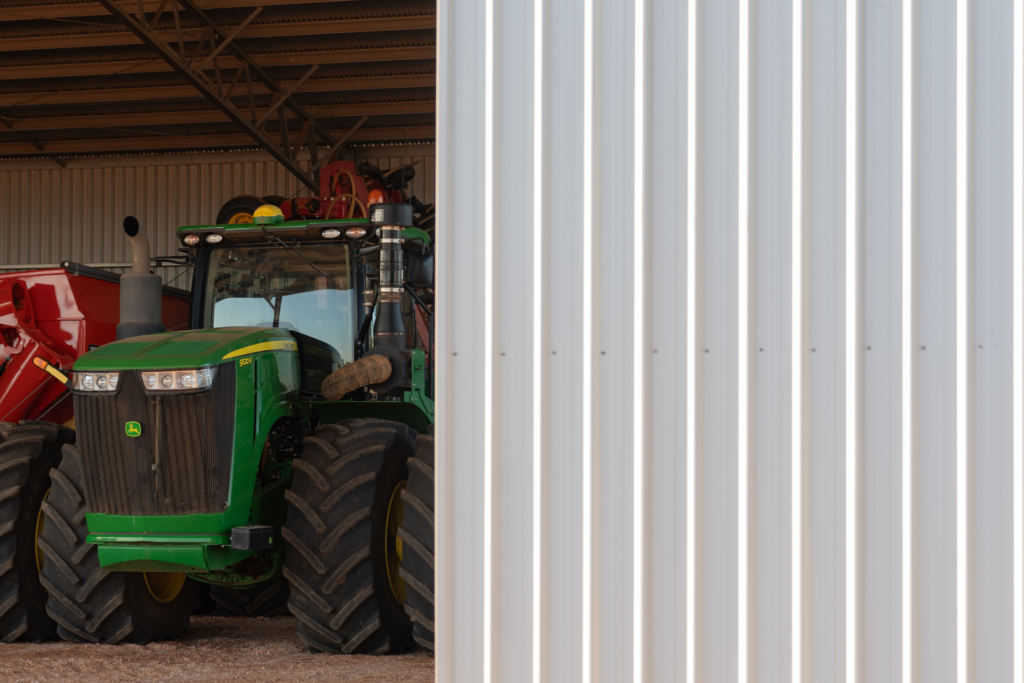
Trimclad Versus Corrugated Iron
Trimclad® is a versatile roof and wall cladding featuring trapezoidal ribs and subtle fluting in the pans. It is ideal for a wide range of applications including farm sheds.
One advantage of Trimclad® is that the cladding can span around 20% further between purlins than corrugated iron. Trimclad® is also by far the most popular of the two cladding profiles, simply due to its more modern appearance.
The classic corrugated iron is a strong and versatile roofing and walling material. Having been in use since as early as the 1840s, any shed built beyond a decade or more ago will most likely be clad with it.
This is often why corrugated iron is used for shed cladding – to match up with other corrugated iron sheds or rainwater tanks that may be nearby. While purely a matter of aesthetics, this might be the deciding factor, so, keep this point in mind and ask yourself what will look best on your farm.
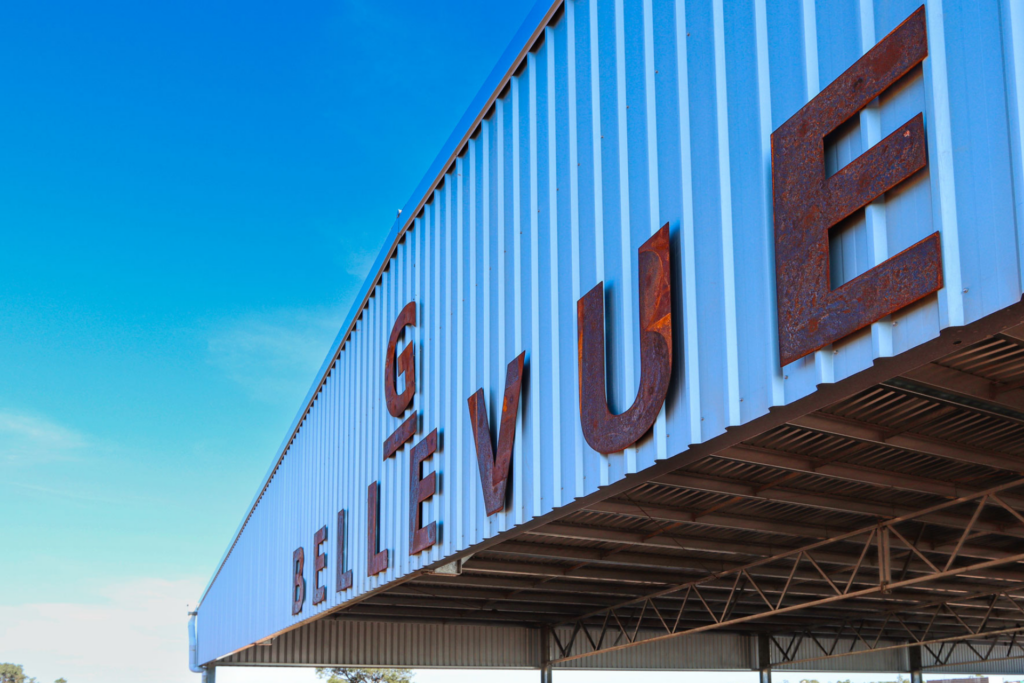
The Verdict – Which Should I Choose?
For the majority of farm shed builds, Trimclad® cladding is the most popular profile choice – but before you make your decision, consider these points:
1. Is there existing infrastructure to match in with? This could include sheds or tanks.
2. What is your personal preference? Sometimes these decisions can simply come down to which option you prefer.
We hope this article and the video have helped to answer your farm shed questions!
For more articles and information like this, browse the Learning Hub.
Or, if you are still looking for answers, call us on 1800 687 888 to speak with one of our building consultants.
